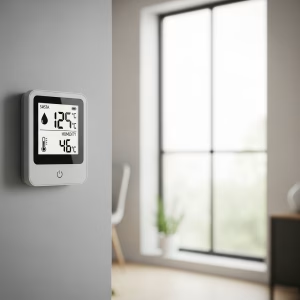Your home security system can be enhanced by using motion sensors and motion detectors to protect you and your family. Motion sensors generally alert you when a person steps into their range, whether by turning on a light, sending you an email, or setting off an alarm. Motion sensors can be placed in your home strategically to maximize their effectiveness when you understand how they work. Using technology to get the most out of your home is more complicated than that.

Types of Motion Sensors
Ultrasonic Sensors
Sensing devices with ultrasonic technology use sound waves to transmit and receive information (with frequencies that exceed human hearing thresholds). Sound waves are bounced off objects and returned by the sensors to determine the distance between them.
In order to calculate the distance to an object, the sensor uses the sound speed in the air. Generally, distance is calculated by multiplying the speed of sound by the time it takes for it to travel. Real-time distance measurements can usually be obtained by the sensor. Sensors can be configured to trigger actions or respond based on distance data, depending on the application. The sensor may open the door when someone approaches, for instance, in an automated door system.
Dual Technology Sensors
The dual technology sensors are used for motion detection to improve accuracy and reduce false alarms. Dual technology sensors combine two or more different sensor technologies. Microwave (MW) and passive infrared (PIR) sensors are most commonly used together.
Combining the output signals from both sensor types is the key to dual technology sensors. A dual tech sensor can only register motion if both the PIR and microwave sensors trigger simultaneously. The dual technology sensor reduces false alarms caused by temperature fluctuations, small animals, or moving objects such as curtains by requiring both sensors to activate before starting an alarm or action.
PIR Sensors
An infrared sensor that detects heat is known as a passive infrared sensor (PIR). Pyroelectric sensors are typically used to detect infrared radiation. A symmetrical, mirror-like arrangement is typical of these sensors. When neither sensor receives motion, it receives the same amount of infrared radiation, resulting in equal electrical outputs.
Warm objects (such as people or pets) enter one sensor’s area before the other when they move within the sensor’s field of view. As a result of this movement, each sensor receives different amounts of infrared radiation. A sensor’s electrical output changes based on the amount of infrared radiation. The PIR sensor produces a digital output, typically a voltage pulse, when the difference between the two readings is processed by its electronic circuitry. A light, alarm, or security system is connected to the PIR sensor to receive the digital work.
Microwave Sensors
Detecting motion by measuring the reflections of microwave signals is the function of microwave sensors, also known as radar sensors. An electromagnetic wave that is generated by a microwave sensor has a wavelength ranging from millimeters to meters. There are usually gigahertz (GHz) signals involved in these signals. Within the field of view of the sensor, objects and surfaces interact with microwave signals emitted by the sensor.
Microwave signals are reflected to the sensor when they encounter objects or obstacles, such as people or vehicles. Sensors receive reflected signals and analyze their frequency shift (Doppler effect) and phase shift to determine whether objects are present and moving. The microwave sensor can be programmed to activate lights, sound an alarm, or activate a security system when motion is detected.
How Do Motion Sensors Work?
It is one thing to understand what motion sensors do, but what is their actual function? What are their methods for detecting movement? A motion sensor detects changes in infrared energy and typically works on the principle of infrared radiation. It is most common to use passive infrared sensors. Motion sensors monitor infrared waves as people and animals walk by, and detect the rapid changes in temperature as a result of those waves.
Microwave motion sensors are also available. Microwaves are sent out and return to a sensor after bouncing off moving objects (in our case, people). A combination of these two technologies can also be used for motion sensors, but they aren’t as common as the previous two.
Where Should Motion Sensors Be Placed?
Place your motion sensor where the action is when deciding where to place it. Especially if you’re using them for security reasons, you should focus on main points of entry. A good place to start is in the foyer, front hall, and back hall.
Your decor will likely look great with this technology. Put them in vignettes (an assortment of items that look good together). A vase, a book, and other household items will blend well with them. Motion sensors should also not be placed in certain areas. Your motion sensor may trigger a false alarm if it is placed near a radiator, since they detect body heat. The technology may be less effective if there is glare or reflection from windows.
Final Verdict
An object in motion, such as a person or an object emitting heat, will cause motion sensors to detect movement and trigger connected devices, such as an alarm or security camera. Your DIY projects can benefit from motion detection, including enhancing the security of your home, reducing energy consumption, and enhancing your energy savings.
In addition to location, height, compatibility with existing smart home systems, and budget, there are several key factors to consider when choosing and installing these devices. After reading this article, do you have a better understanding of motion sensor technology? If you found this article useful, be sure to share it with others. If you want to learn more then check out on Chenaniot.




